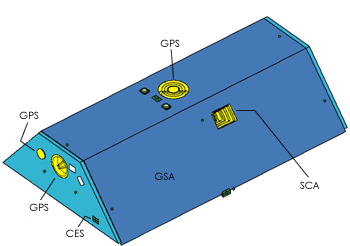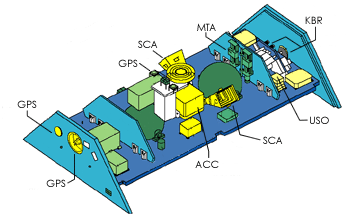
|
GRACE Publications |
|
Key Spacecraft Components Now that we have an idea how GRACE works, let's peer "under the hood" of this high-tech wonder and understand some of the component parts of GRACE. These components can be seen in the photos on pages 2 and 4; the letters following the name of each component in parentheses correspond to the labels on the diagrams below each photo.
K-band Ranging System (KBR). Provides precise (within 10 Ám) measurements of the distance change between the two satellites needed to measure fluctuations in gravity. Ultra Stable Oscillator (USO). Provides frequency generation for the K-band ranging system. SuperSTAR Accelorometers (ACC). Precisely measures the non-gravitational accelerations acting on the satellite. Star Camera Assembly (SCA). Precisely determines the two satellites' orientation by tracking them relative to the position of the stars. Coarse Earth and Sun Sensor (CES). Provides omnidirectional, reliable, and robust, but fairly coarse, Earth and Sun tracking. Used during initial acquisition and whenever GRACE operates in safe mode. Center of Mass Trim Assembly (MTA). Precisely measures the offset between the satellite's center of mass and the "acceleration-proof" mass and adjusts center of mass as needed during the flight. Black-Jack GPS Receiver and Instrument Processing Unit (GPS). Provides digital signal processing; measures the distance change relative to the GPS satellite constellation. Globalstar Silicon Solar Cell Arrays (GSA). Covers the outer shell of the spacecraft and generates power. |



